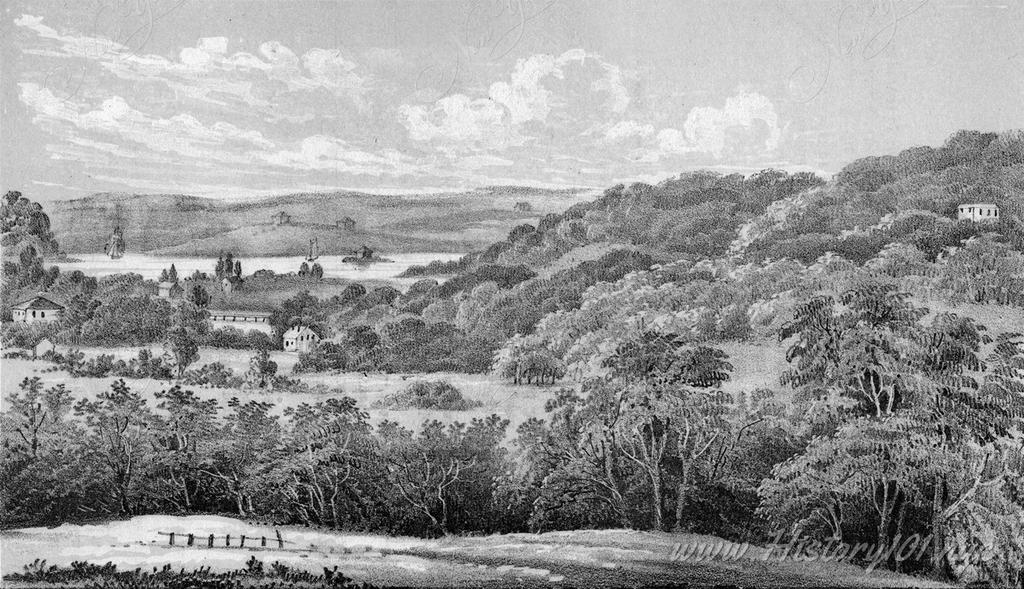
1800-1840 NYC: Bustling Port to Commercial Powerhouse: The Shaping of a Global City
The early 19th century, spanning from 1800 to 1840, was a time of profound change and growth for New York City. This period marked the city’s transformation from a bustling port into a global commercial hub. A pivotal catalyst for this change was the opening of the Erie Canal in 1825, which established New York City as a vital center for global trade and a gateway to the New World.
This era also witnessed significant technological advancements, particularly the introduction of steam power. Innovators like Robert Fulton were instrumental in integrating steam-powered solutions into the city’s infrastructure, setting the stage for the forthcoming Industrial Revolution. These technological breakthroughs fueled economic growth, exemplified by the establishment of the New York Stock & Exchange Board and the construction of iconic structures such as City Hall and the Fulton Fish Market.
In tandem with these developments, the city’s physical landscape experienced a dramatic transformation. The completion of the Croton Aqueduct in 1842 revolutionized New York City’s water system, markedly improving public health and accommodating its burgeoning population. During this time, areas like Harlem transitioned from rural landscapes to vital components of the urban setting, while Broadway evolved from a simple dirt path into a vibrant thoroughfare.
However, this period was not without challenges. As the population soared, the city faced significant social issues, including public safety concerns due to fires and poorly constructed buildings, as well as heightened tensions from a diverse and rapidly growing population. These challenges led to the establishment of new building codes and governance structures, aiming to safeguard the well-being of the city’s inhabitants.
In conclusion, the years between 1800 and 1840 were a defining epoch for New York City, characterized by remarkable growth, technological innovation, and social change. The developments during these four decades were crucial in shaping New York City’s trajectory as a global metropolis, laying a strong foundation for its future as one of the world’s preeminent urban centers.
Timeline of New York City’s History 1800-1840’s
Discover surprising historical facts about The City That Never Sleeps—explore fun, educational insights into its history, population, iconic landmarks, and more, perfect for students, history enthusiasts, and anyone curious about NYC’s rich heritage.
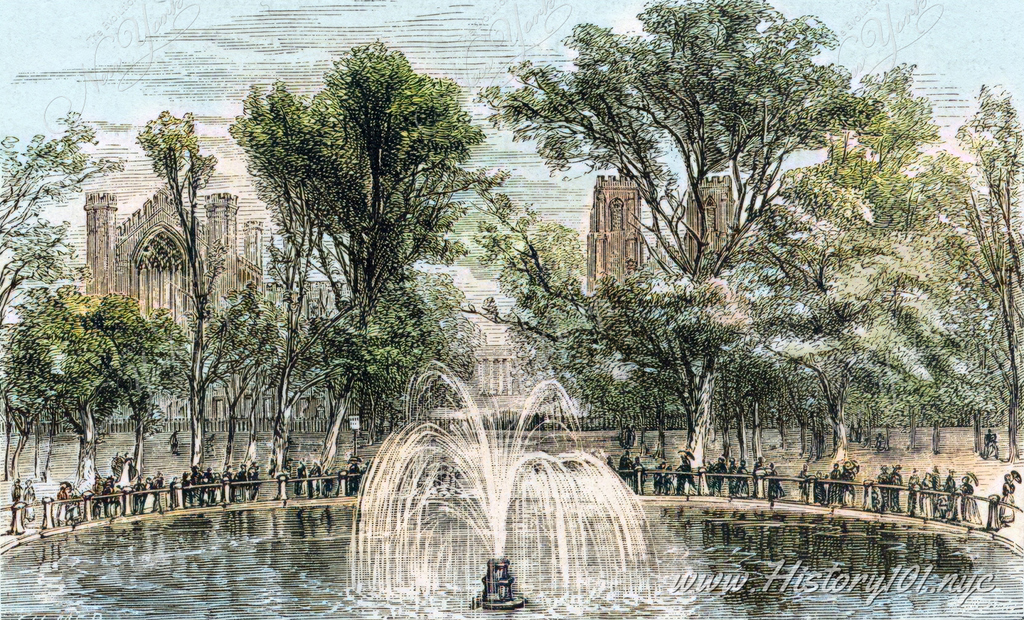
1801: Washington Square Park Fountain
In 1801, Washington Square Park, with its iconic fountain, was a focal point of social and cultural life in New York City, emblematic of the city's burgeoning public spaces.
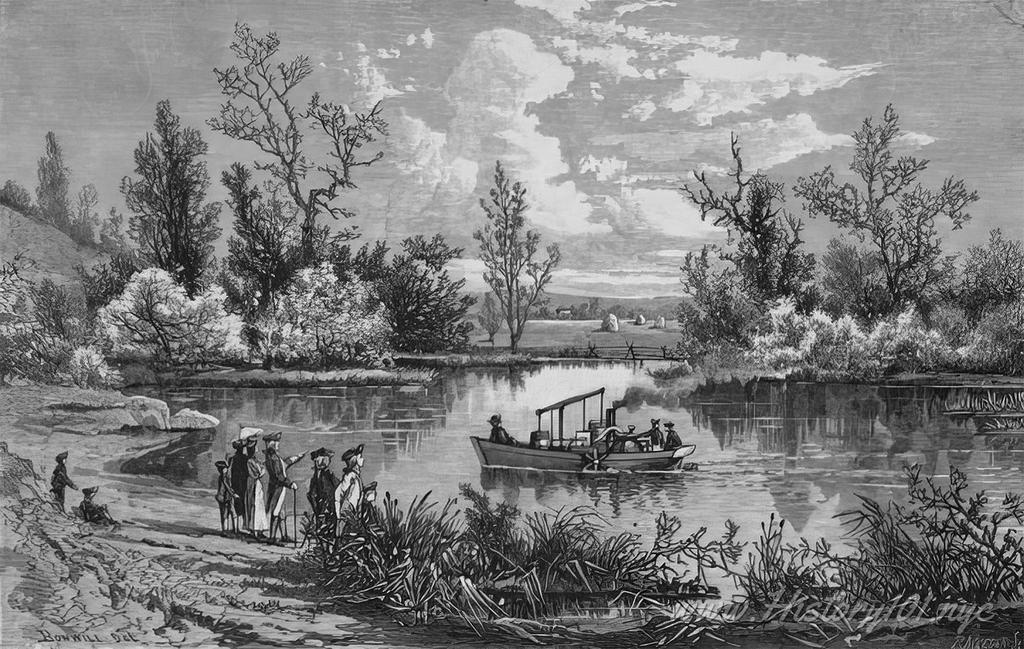
1801: Transformation of The Collect Pond: A Glimpse into New York City's Historical Landscape
Explore the evolution of Collect Pond, from a crucial NYC water source to the historical Collect Pond Park in modern Chinatown
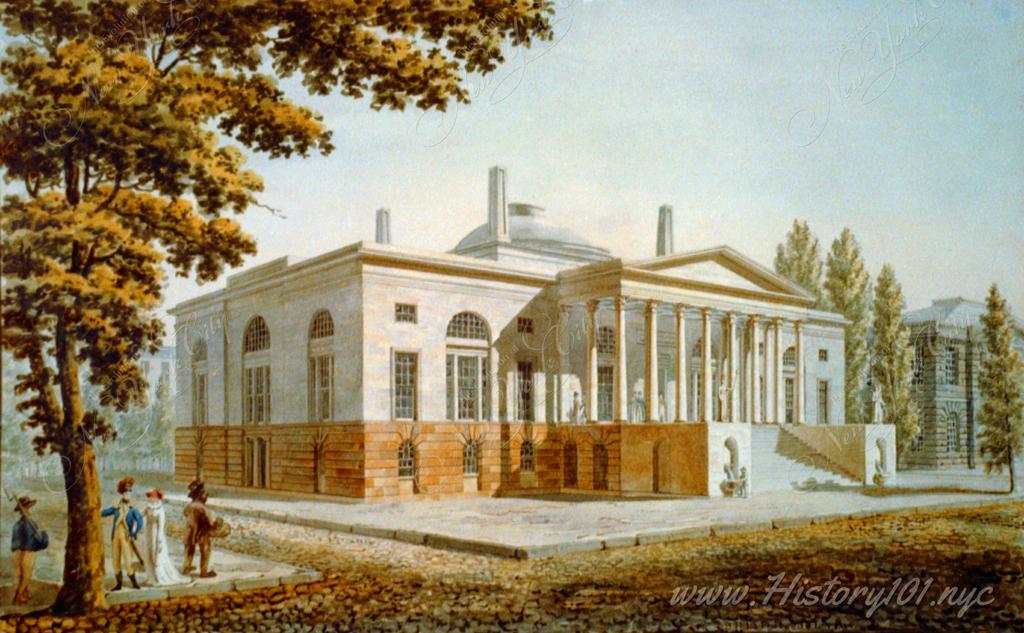
1802: New York City Hall Design Competition: A Landmark Event in Urban and Architectural History
Explore the 1802 design competition for NYC City Hall, an event marking the city's growth and architectural ambitions in the early 19th century
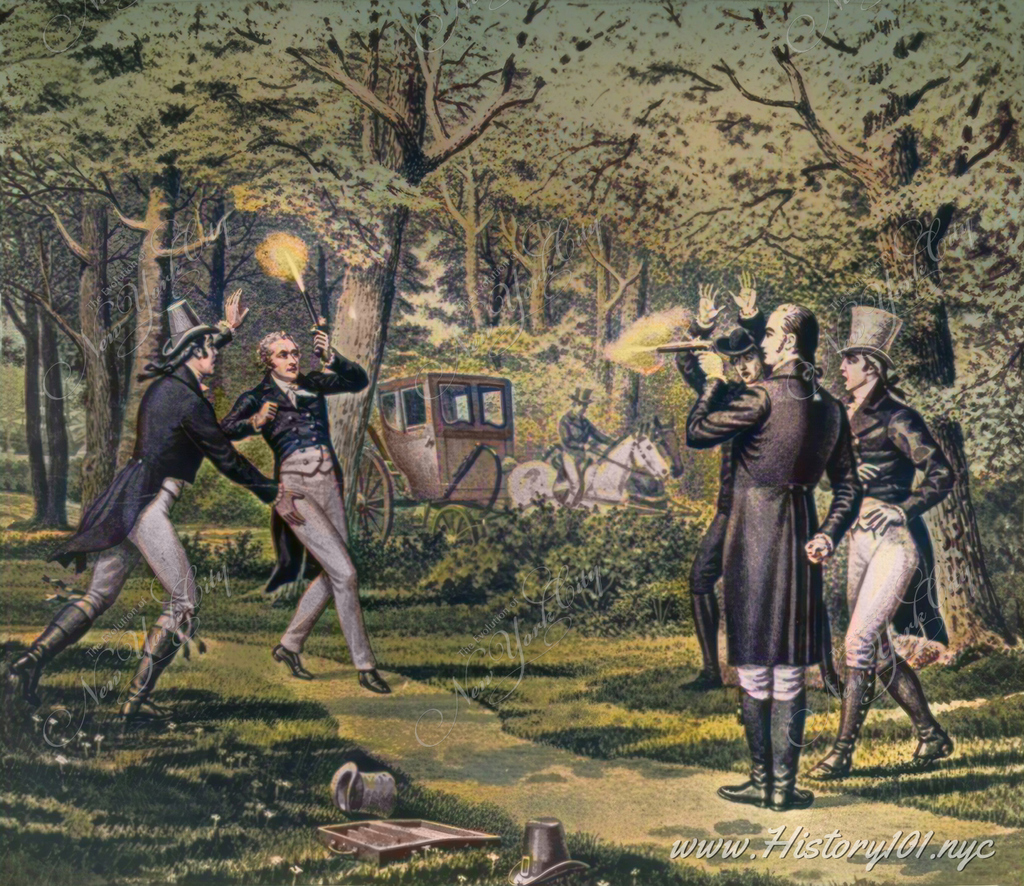
1804: Burr-Hamilton Duel: Defining Moment in Early American and NYC History
Discover how the Burr-Hamilton duel, captured in History101's exclusive colorized version, influenced America and New York's early political landscape
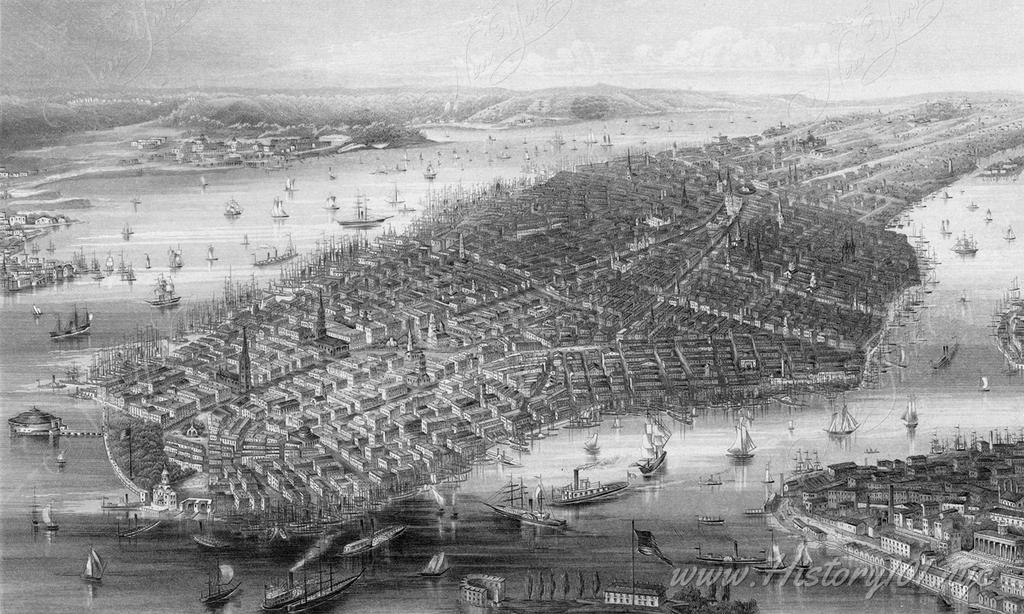
1812: Aerial View of Manhattan: A Glimpse into NYC's Early Urban and Maritime History
A bird's eye view of downtown Manhattan and New York Harbor with plenty of ships
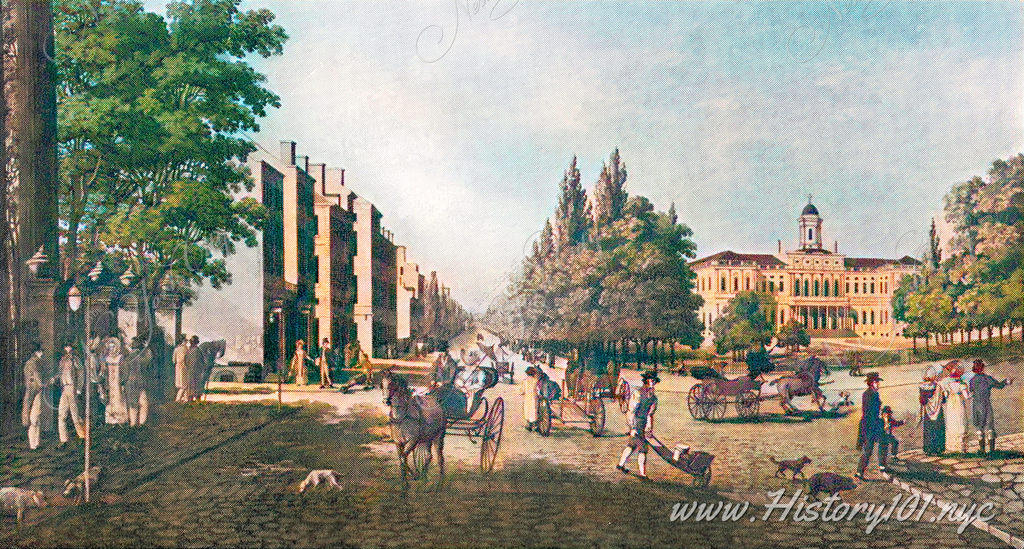
1820: City Hall Broadway
In 1820, City Hall Broadway, later known as City Hall Park, existed as a prominent civic space in New York City. The park was situated in the vicinity of Broadway and Park Row, near City Hall.
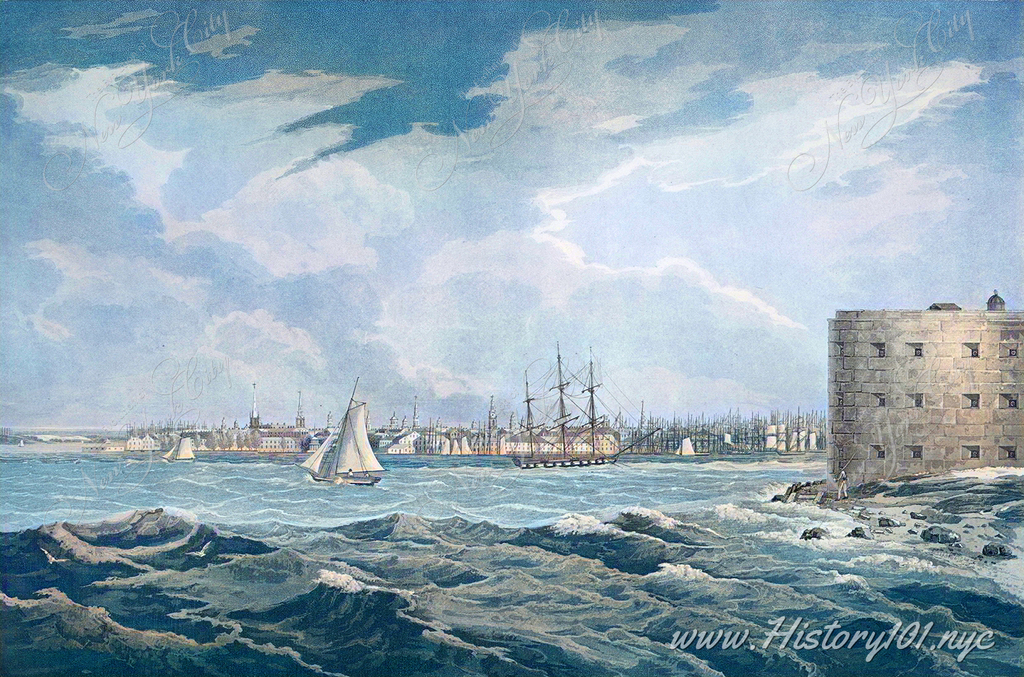
1820: New York from Governors Island
Print shows a view of New York City from Governors Island with a soldier patrolling outside a fortification, and a sailboat and sailing ship in the harbor with the city in the background.
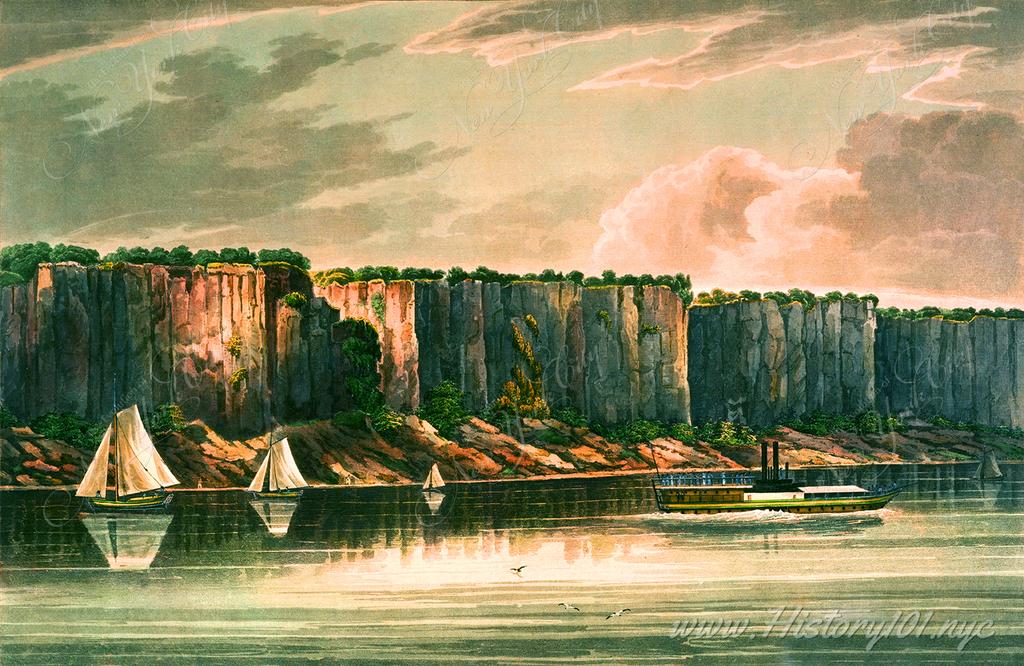
1823: The Palisades
A painting of the Palisades - a line of steep cliffs along the west side of the lower Hudson River in Northeastern New Jersey and Southeastern New York.
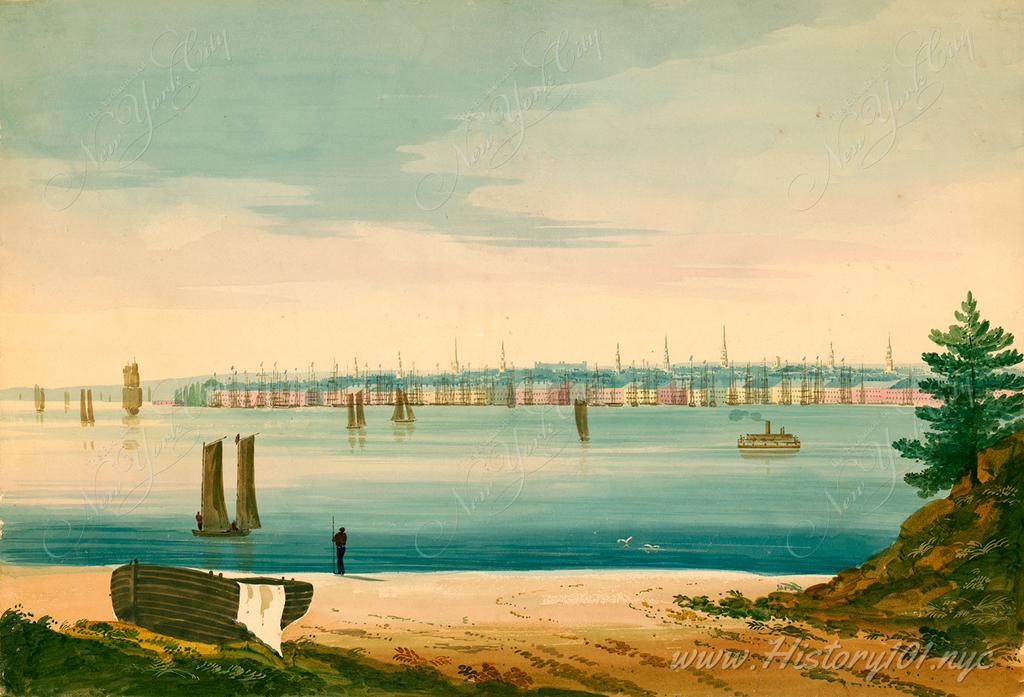
1825: Manhattan's Skyline from Brooklyn
Drawing shows lower Manhattan across the East River with sailboats, sailing ship, and steamship in the river.
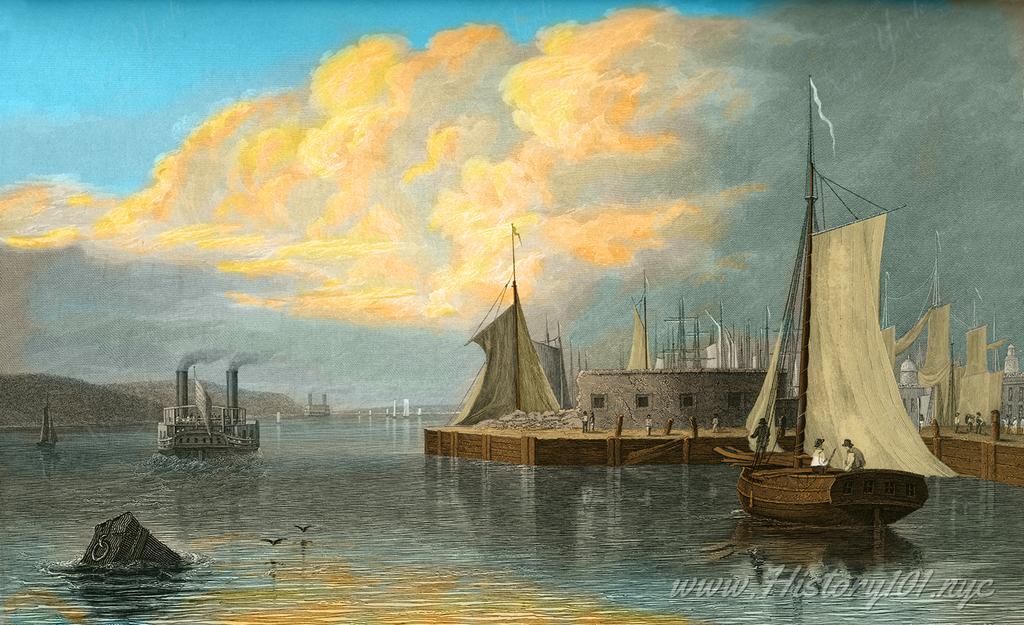
1825: Robert Weir's Sunset at The Battery, NYC: Art and History Intertwined
Explore Weir's 1825 masterpiece, 'Sunset at The Battery, NYC', capturing a pivotal moment in New York's history and landscape art
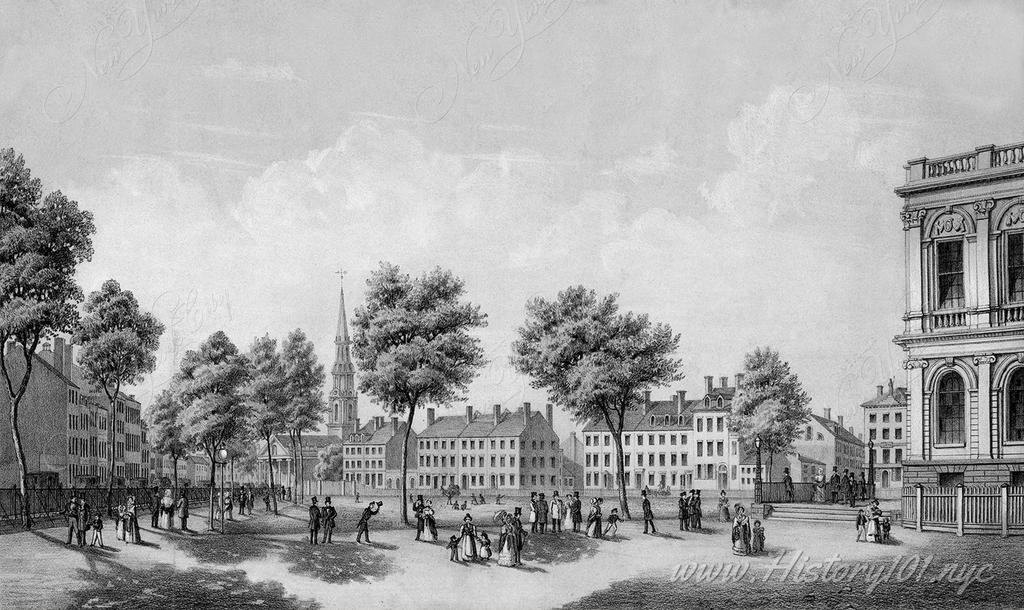
1827: Street Scene near City Hall
Illustration of pedestrians walking near City Hall. Saint Paul's chapter is visible in the background skyline.
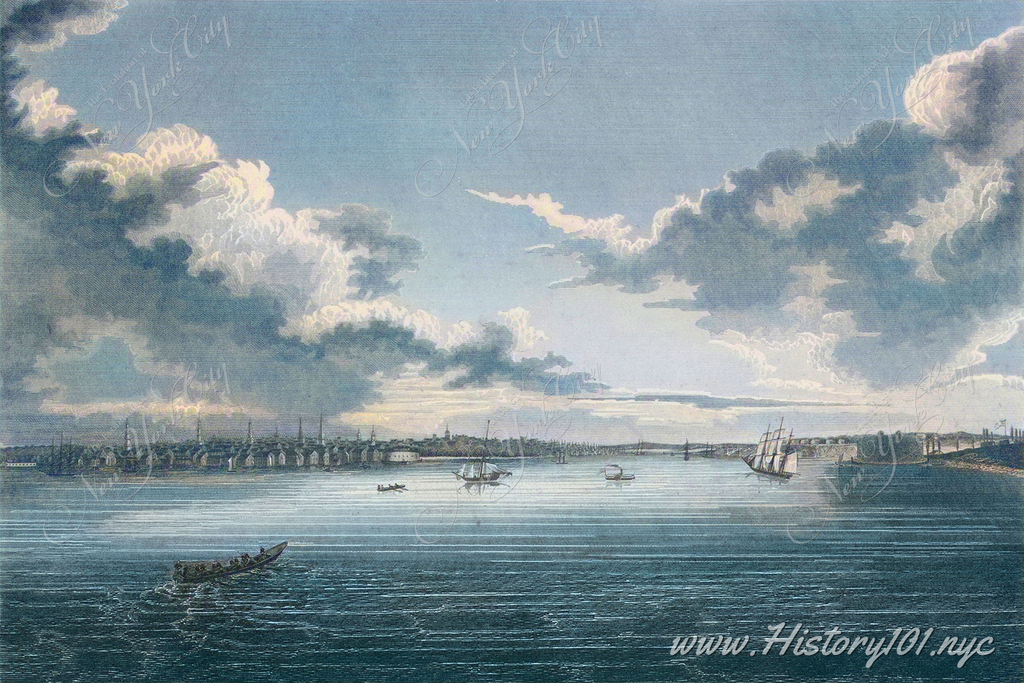
1828: New York Harbor
Illustration of the New York Harbor from the south, looking across to Manhattan. Castle Williams on Governors Island is visible in the foreground.
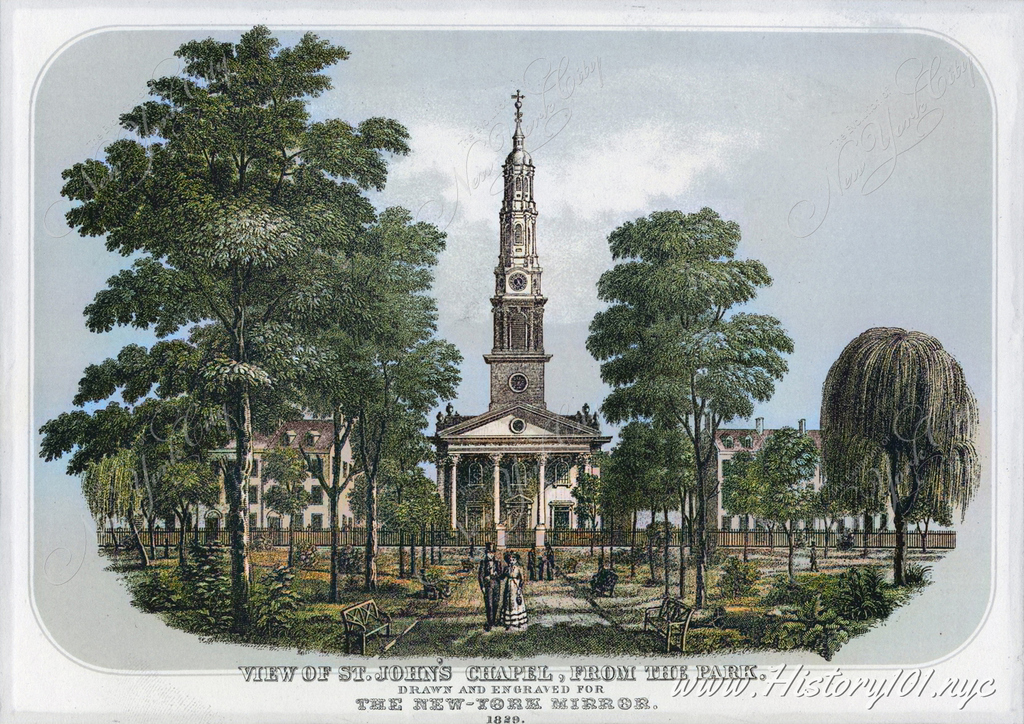
1829: Saint John's Chapel & Park: NYC's Testament to Heritage and Urban Growth
Explore the legacy of Saint John's Chapel and its transformation into James J. Walker Park, reflecting NYC's journey from historic serenity to urban vibrancy
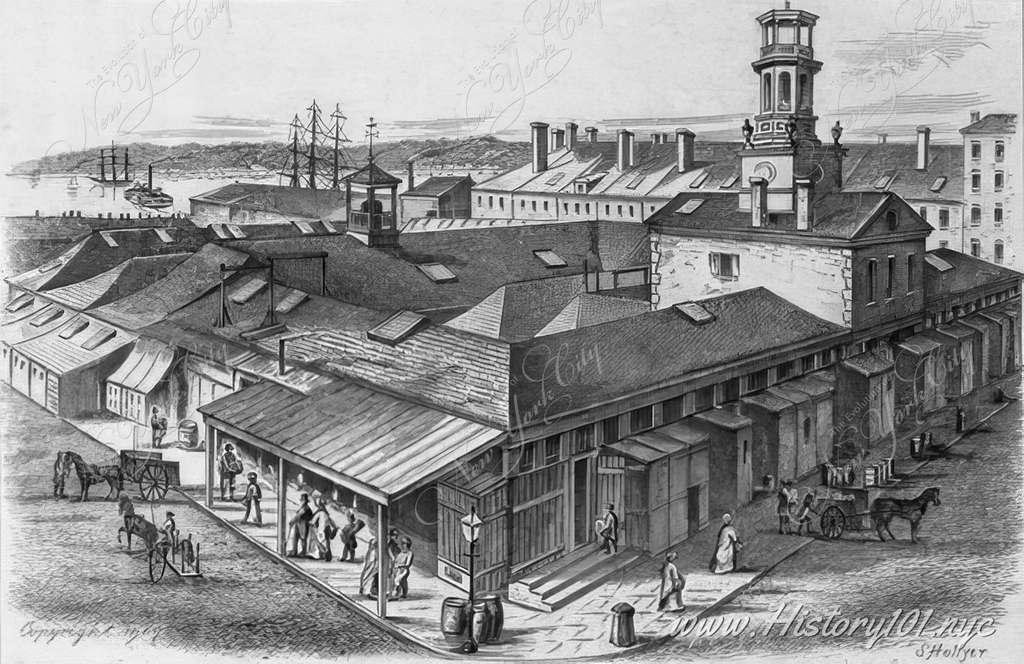
1829: The Washington Market
The Washington Market was built in 1813 near the Hudson River in what is now Tribeca. By 1829 it grew to be the largest wholesale market in the city and nation at the time.
Timeline of New York City: 1800-1840
1800: New York City's population reached about 60,515, as per the United States Census. This figure marks a notable rise from the 1790 population of approximately 33,131, reflecting the city's rapid growth over a decade. Factors fueling this expansion included immigration, economic opportunities, and the city's emerging status as a key commercial and cultural center.
This era's growth was pivotal in shaping the United States' economic, political, and cultural framework. New York City's evolution into a vital trade and commerce hub was driven by sectors like shipping, finance, and manufacturing, cementing its role as a crucial urban center in the nation's trajectory.
1801: The New York Evening Post began its publication on November 16, a significant event in the city's journalistic landscape. Founded by Alexander Hamilton, a prominent Federalist, the newspaper served as a voice for Federalist views, countering the Republican-leaning New York Aurora. Hamilton's leadership was instrumental in shaping the newspaper's early influence, establishing it as a major player in the political and journalistic spheres of the time."
Transforming through the years, the New York Evening Post experienced numerous editorial and structural changes, leading to its rebranding as the New York Post in 1934. Today, the New York Post remains an integral part of the city's media, offering diverse coverage ranging from politics and breaking news to entertainment and lifestyle, maintaining its status as a key publication in New York City's vibrant press scene.
1801: The New York Constitutional Convention primarily addressed judicial reforms in 1801, marking an early effort to modify the state’s governance in response to demographic changes and evolving needs. Notably, this convention did not implement changes such as adjusting the number of senators or assemblymen or instituting periodic reviews of legislative representation; these were introduced in subsequent gatherings.
The pivotal 1821 convention significantly overhauled New York’s legislative framework by restructuring the Senate and Assembly and broadening suffrage. These reforms were crucial for ensuring that the state’s legislative bodies accurately represented its diverse and expanding population. This was particularly beneficial for New York City, enhancing its representation and influence within state governance, and supporting its continued growth as a major urban and economic hub.
1802: The American Academy of the Fine Arts emerged as a cornerstone in New York City's cultural and artistic development, ranking among the United States' earliest significant art institutions. Its establishment signified New York's ascent as a center for artistic endeavors, emphasizing its role in nurturing the fine arts through exhibitions and education. This initiative marked a pivotal moment in the city's transformation into an artistic hub of the new nation.
Facing competition, notably from the National Academy of Design established in 1825, the Academy's early influence waned. This rivalry encapsulated the dynamic, evolving nature of NYC's art scene. The American Academy, once a beacon of artistic innovation and education, gradually diminished in prominence, overshadowed by the National Academy's ascendancy, mirroring the shifting paradigms in the city's artistic and cultural spheres.
1804: Established on November 20, the New-York Historical Society became New York City's inaugural museum and historical organization, a key milestone in preserving American historical narratives. Its formation, a response to the burgeoning interest in the nation's past, initiated the systematic preservation of significant documents
Over time, the society evolved into a central repository and research hub, its collections encompassing manuscripts, books, maps, artworks, and photographs. These diverse holdings offer comprehensive insights into both New York's and America's historical tapestry. Playing an essential role in historical study, the society has become a pivotal resource for scholars, historians, and the public, keen on exploring the intricate layers of the city's and country's history.
1806: Eliza Hamilton, wife of Alexander Hamilton, along with fellow advocates, founded the New York Orphan Asylum Society, New York City's first private orphanage. The initiative began on March 15, 1806, at the City Hotel, leading to the establishment of a residence on Raisin Street that initially provided shelter to 16 children. This significant step played a pivotal role in addressing the needs of the city's orphaned children
Eliza Hamilton's dedication was remarkable; she became the society's director in 1821, actively contributing into her 90s. The society's evolution and relocation, including the 1835 move to Bloomingdale village and the subsequent new asylum built by 1837, laid the groundwork for what is now Graham Windham. This foundation played a key role in New York City's social and humanitarian progress, particularly in child welfare and education.
1807: Washington Irving's Salmagundi, first published on November 11, introduced "Gotham" as a nickname for New York City. The term, originally describing a village in England whose inhabitants pretended to be mad to avoid royal attention, was used by Irving to satirize New York City's societal quirks. This playful moniker captured the city's eccentricities and has since become a key part of its identity.
"Gotham" soon embedded itself in New York City's cultural lexicon, influencing its portrayal in literature and media for centuries. This nickname helped shape the city's image as a place of unique character and charm, contributing to its historical and cultural narrative and enduring as a symbol of New York City's distinctiveness and allure.
1807: The College of Physicians and Surgeons is established in New York, later integral to Columbia University's medical school, was a cornerstone in American medical education's transformation. Initially signaling a departure from apprentice-based training to formalized, structured learning, it set unprecedented medical standards nationwide.
Beyond elevating practices in New York, its influence extended across the U.S., reshaping healthcare and medicine's historical narrative. The institution's sustained contribution in medical education and research underpins its enduring impact on American healthcare advancements. This pivotal role in the evolution of medical practices marks it as a key architect in the country's healthcare development.
1807: On August 17, Robert Fulton's steamboat, the Clermont, embarked on a landmark voyage from New York City's North River, now the Hudson River. Starting from Cortlandt Street in Manhattan to Albany, the steamboat covered approximately 150 miles in a mere 32 hours, eclipsing the efficiency of prior transportation methods. This maiden journey not only demonstrated the practicality of steam-powered navigation but also signified a major leap in transportation and industrial innovation in the United States.
Fulton's ingenuity in overcoming technical hurdles, including developing a robust steam engine, designing an efficient propeller system, and constructing a durable, seaworthy hull, was pivotal. The Clermont's successful voyage marked the dawn of a new era in technological advancement, significantly influencing the course of American transportation history.
1807: New York City's urban landscape underwent a transformative change in 1807 when the Common Council appointed Gouverneur Morris, Simeon De Witt, and John Rutherford to plan Manhattan's streets and public spaces, particularly focusing on the area above Canal Street.
This strategic move aimed to address the city's expanding needs. The trio's efforts resulted in the Commissioners' Plan, also known as the Randel Survey after John Randel, Jr., the surveyor and drafter. Published in 1811, this plan introduced a groundbreaking rectangular grid system, now a defining characteristic of Manhattan. This grid not only redefined the city's topography but also set the stage for its future growth, fundamentally impacting its urban design and development.
1808: The Roman Catholic Diocese of New York was established, responding to the city's growing Catholic population, largely driven by European immigration. This institution played a crucial role in New York City's evolving religious and cultural landscape, reflecting its increasing diversity. The Diocese, which was later elevated to an archdiocese, became pivotal in providing essential services such as education, healthcare, and welfare, primarily through schools, hospitals, and orphanages.
Its presence significantly influenced the city's social fabric, aiding in the integration of immigrant communities. This establishment marked a key point in the city's history, not only serving the spiritual needs of Catholics but also contributing to New York's social and architectural heritage.
1809: The New York State Legislature settled into its new State Street building in Albany in 1809, solidifying the city's role as the state capital since 1797. This new legislative building became the cornerstone for state government operations, reinforcing Albany's stature as New York State's administrative hub.
Meanwhile, this shift allowed New York City to pivot away from governmental functions towards becoming a global commercial and financial nucleus. No longer the state capital, NYC invested heavily in expanding its commercial infrastructure and financial services, setting the stage for its emergence as a worldwide economic leader.
1809: New York City's Abyssinian Baptist Church is established and one of the oldest African American Baptist churches in the U.S. Founded due to racial segregation in the First Baptist Church of New York, it became a significant religious and cultural cornerstone for African Americans. This church has long been a central hub for civil rights advocacy and social justice, participating in anti-slavery and anti-discrimination movements.
Additionally, it has provided crucial community services, such as educational and support programs, playing a key role in community development and empowerment. Its foundation and continuous presence in New York City stand as testaments to the African American community's resilience and cultural heritage.
1809: Washington Irving's "A History of New York," also known as "Knickerbocker's History of New York," marked a pivotal moment in American literature. This satirical work, blending humor with historical narrative, was instrumental in developing a uniquely American literary voice. Its whimsical depiction of New York's Dutch era not only reflected Irving's literary prowess but also significantly influenced the city's cultural identity.
Irving's publication introduced "Knickerbocker" as a synonymous term for New Yorkers, embedding it deeply into the city's lexicon and identity. The book's portrayal of New York's history played a key role in shaping the city's image and cultural perception, both locally and nationally. Recognized as a cornerstone in American literary history, it highlighted the city's evolving narrative and historical significance.
1810: Scudder's American Museum is established in New York City and was a pioneering cultural institution in the U.S., showcasing an eclectic mix of natural wonders, artifacts, and oddities. Its introduction marked a significant milestone in New York's cultural and educational development. As one of the earliest museums, it enriched the city's educational and cultural landscape, appealing to a wide audience with its vast and varied collection.
Quickly becoming a key attraction, the museum played a dual role in education and entertainment, sparking interest in natural history and science. It significantly influenced New York City's emergence as a hub for cultural and educational pursuits. The museum's success in drawing crowds and its approach to display and education set standards for future institutions, contributing to the evolution of museum practices and public education in the city.
1811: While the specific fire on Chatham Street (now Park Row) in New York City isn't widely recorded, some historians note May 19th as a possible date. Numerous fires were common in the city during this period, primarily due to the prevalent use of wood in construction and primitive firefighting technology. These incidents often resulted in substantial property damage, prompting significant changes in urban design and firefighting methods.
These fires profoundly impacted New York City, catalyzing advancements in firefighting techniques and leading to the establishment of more efficient fire brigades. They also highlighted the need for improved urban planning and stricter building regulations, particularly regarding materials and street designs. Furthermore, these events strengthened community bonds, fostering unity and cooperation among residents. This period also witnessed economic and social shifts, leading to urban renewal and the transformation of affected neighborhoods, playing a crucial role in shaping the city's future development.
1811: Born in New York City on August 29, Henry Bergh was a seminal figure in American social reform, founding the ASPCA in 1866—the first animal welfare organization in North America. He also co-founded the NYSPCC in 1875, significantly advancing child protection efforts. Bergh's death in 1888 left a durable legacy of advocacy for humane treatment.
Bergh's initiatives positioned New York City as a trailblazer in social reform, particularly in animal and child protection. His leadership in establishing the ASPCA and NYSPCC catalyzed legislative changes and heightened public awareness about cruelty. These organizations, originating in New York, spurred global movements, cementing the city’s role as a vanguard of societal reform.
1811: The Commissioners' Plan of 1811, a visionary urban layout, was adopted by the New York State Legislature, radically transforming Manhattan's landscape. Designed by three appointed commissioners, this plan replaced the chaotic maze of narrow alleys with a systematic grid of streets and avenues from 14th Street to Washington Heights, facilitating efficient urban planning and transportation. This marked a significant shift towards a more organized and navigable city structure, enhancing Manhattan's functionality and growth potential.
The grid system profoundly impacted New York City's development, streamlining navigation and setting the stage for future urban and socio-economic expansion. It also incorporated provisions for public parks, paving the way for iconic green spaces like Central Park. This plan was pivotal in shaping Manhattan’s future, laying a foundational grid that directed the city's growth, urban design, and infrastructure development, thus playing a crucial role in the city's historical evolution.
1812: New York City Hall is built, designed by John McComb Jr. and Joseph François Mangin, is a hallmark of American Federal architecture. Situated in Lower Manhattan, it has been the government's seat, symbolizing the city's rise as a political and economic center in the early 19th century. This landmark epitomizes a significant phase in New York's architectural and civic evolution, reflecting its growing importance in the nation.
City Hall's influence extends beyond architecture; it's the nucleus of the city's civic and cultural life, hosting key events and ceremonies. Its establishment marked a turning point in downtown Manhattan's urban and architectural development, reinforcing its role in the city's narrative. As a focal point for civic engagement, City Hall has profoundly shaped New York's political and social landscape, solidifying its position as a pivotal historical landmark.
1812: The War of 1812, lasting from 1812 to 1815, significantly impacted New York City, a major U.S. port. British blockades disrupted trade, challenging the city's economy, yet simultaneously spurred growth in shipbuilding and privateering. This period also saw enhanced defensive measures, including fort and battery construction, as the city fortified against potential British attacks.
Post-war, New York City experienced a surge in nationalism and unity, supporting a resilient recovery and urban development. This era was pivotal in shaping the city's economic and social fabric, fostering growth and infrastructure improvements. Emerging stronger from the conflict, New York City solidified its role as a key American urban center, laying a foundation for future expansion and resilience.
1816: Founded on May 11, in New York City, the American Bible Society was one of the first organizations dedicated to distributing Bibles worldwide in local languages. Its establishment was a key event in the city's history, reflecting the burgeoning religious and philanthropic spirit of the early 19th century. The Society's mission to make scripture widely accessible underscored New York's growing role in religious and societal movements.
The Society's influence in New York was profound, promoting literacy and education through Bible reading and contributing to social reforms by distributing Bibles to hospitals and prisons. These efforts reinforced New York City's position as a center for religious and charitable organizations and significantly boosted the local publishing industry, fostering advancements in printing and distribution. The American Bible Society's founding not only shaped the city's religious landscape but also its cultural and industrial growth.
1817: The New York Stock & Exchange Board is established, later renamed the New York Stock Exchange (NYSE), marked a defining moment in the financial history of both New York City and the United States. This pivotal transformation underscored the Exchange's burgeoning significance in the global financial arena. From its early days, the NYSE began shaping American financial markets, setting the stage for its emergence as a worldwide financial leader.
The evolution from the New York Stock & Exchange Board to the NYSE symbolized a leap in global financial dominance. It swiftly became a crucial hub for capital raising and securities trading, driving American economic growth. Today, the NYSE stands as one of the largest global stock exchanges, boasting a market capitalization exceeding $25 trillion and an average daily trading volume over 1 billion shares. Its growth reflects its critical role in international finance and its substantial influence on New York City's economic fabric.
1817: The 1817 New York State legislation paved the way for the abolition of slavery by 1827, a significant milestone in America's abolitionist movement. The law, showcasing New York’s commitment to human rights, mandated that children born to enslaved mothers after July 4, 1799, would be liberated yet remain indentured servants into their twenties. This move not only reflected the state's progressive ideals but also set a precedent for other states in matters of social reform.
This legislative action profoundly impacted New York City, bolstering its reputation as a hub for progressive change and cultivating a diverse, dynamic populace. The emancipation of enslaved people broadened the labor market and enriched the city’s cultural and social landscape. As a result, NYC evolved into a significant multicultural and economic center, with former slaves contributing to its population growth and actively engaging in its economic and cultural spheres.
1817: The Staten Island Ferry is established, revolutionizing transportation in New York City by forging a critical link between Staten Island and Manhattan. This service significantly enhanced city connectivity, easing travel for residents and aiding daily commutes. As a pivotal addition to New York City's transportation network, the ferry streamlined movement between boroughs, proving essential for thousands daily.
The ferry's influence extended beyond transportation, spurring Staten Island's economic and residential development by integrating it into the city's broader economic context. Its establishment made the island more desirable for living and working, while the ferry itself emerged as a cultural symbol and tourist draw, offering picturesque views of New York Harbor and the Statue of Liberty. This integration not only transformed transportation but also enriched New York City's cultural and recreational tapestry.
1818: The Lyceum of Natural History is established, later the New York Academy of Sciences, significantly advanced scientific knowledge and education in New York City. Focusing on biology, geology, and chemistry, it became a key center for scientific research, offering lectures, exhibitions, and publications. This institution engaged both the scientific community and the public, enhancing the city's role in scientific inquiry.
The Lyceum's founding marked New York City as a major intellectual and cultural hub, attracting renowned scientists and thinkers, and bolstering its cultural life. It played a vital role in collecting and preserving natural specimens, contributing to a deeper understanding of the natural world. This groundwork was pivotal in establishing New York City as a leader in scientific research and education, influencing the development of future scientific institutions.
1818: Founded by Henry Sands Brooks, Brooks Brothers opened at Catherine and Cherry Streets in Lower Manhattan, New York City, pioneering the American ready-to-wear fashion scene. As the first of its kind in America, Brooks Brothers initiated a transformative era in the U.S. retail and fashion industries, earning the title of the nation's oldest clothing retailer.
Brooks Brothers' inception significantly influenced New York City's commercial and fashion realms. Introducing ready-made suits, the store redefined American apparel shopping and wearing habits, boosting Lower Manhattan's development as a commercial nucleus. This innovation not only positioned the brand as a cultural symbol but also set new trends in American fashion. Brooks Brothers' legacy in retail and garment production has left an indelible mark on New York City's economic and cultural fabric.
1818: The Rotunda, New York City's inaugural art gallery, was established in 1818 in City Hall Park, marking a significant cultural evolution. This initiative not only introduced the tradition of situating museums in park areas but also demonstrated the city's early efforts to make art publicly accessible, fostering a community-oriented cultural atmosphere. The Rotunda's strategic placement in a notable public space emphasized the city's commitment to integrating art into everyday life.
By 1870, The Rotunda was demolished, yet its historical significance in shaping New York City's cultural landscape remains profound. Its inception and subsequent removal reflect the city's dynamic progression in urban and cultural development. The Rotunda's legacy continues to influence New York City's approach to public space utilization and cultural inclusivity, embodying a persistent dedication to the arts that characterizes the city's identity.
1819: Introduced on May 21, velocipedes, known as the first bicycles in the United States, marked a significant evolution in personal transportation, debuting in New York City. These rudimentary bicycles, built with wooden frames and two wheels, required riders to propel themselves by pushing off the ground. This innovation heralded a new era in mobility.
New York City, a leading center for new technologies, embraced the velocipedes, which significantly altered its urban landscape by enhancing mobility and leisure. The introduction of these early bicycles showcased the city's adaptability and forward-thinking approach, reinforcing its status as a cultural and technological vanguard during the 19th century.
1819: Opening its doors on July 3, the Bank of Savings became the first U.S. savings bank, situated in New York City. It was created to meet the financial needs of the working and middle-class populations, offering a secure place for their savings. As a trailblazer in the banking sector, the Bank of Savings set a model for subsequent savings banks across the nation.
The establishment of the Bank of Savings significantly boosted New York City's economic landscape, strengthening its reputation as a financial center. The bank played a crucial role in promoting financial stability and growth by making savings accessible to a wider audience. This pivotal development reinforced NYC’s leadership in financial innovation and secured its progression into a leading global financial capital.
1819: The yellow fever epidemic in New York City, part of a series of outbreaks in U.S. cities, prompted significant changes in public health and urban policy. This epidemic underscored the urgency of enhanced disease control, leading to improvements in city sanitation and public health infrastructure. The crisis galvanized advancements in medical practices and healthcare facilities, fundamentally altering the city's approach to public health.
Responding to the epidemic, New York City authorities focused on urban sanitation and planning, improving air circulation and cleanliness in populous areas. These measures not only addressed immediate health concerns but also set a precedent for future urban development and health crisis management. The 1819 epidemic thus played a crucial role in shaping New York City's public health strategy and urban living conditions, marking a turning point in the city's approach to managing health emergencies.
1819: Herman Melville, celebrated for "Moby-Dick" and "Billy Budd," was born in New York City on August 1. His narratives, enriched by seafaring experiences and a deep understanding of humanity, secure his status in American literary history. Melville died on September 28, 1891, leaving a legacy revered in academic and literary circles.
New York City, Melville’s birthplace, significantly benefits from its association with this literary giant. The city's cultural tapestry is bolstered by its history as a nurturing ground for prominent artistic and intellectual figures. This affiliation not only enriches New York's historical narrative but also highlights its enduring role as a crucible of literary and cultural innovation.
1820: The Apprentices' Library is established, later the General Society Library, was one of America's first free libraries. Aimed at providing educational resources to young tradesmen and apprentices, it marked a pivotal advancement in making education and knowledge accessible, especially for working-class youth. This development was a significant stride in democratizing education in an era with limited educational opportunities for this demographic.
The library's founding significantly enhanced New York City's cultural and intellectual fabric. It fostered literacy and self-education across various social strata, establishing itself as a crucial cultural and social hub. By setting a precedent for public education access, the Apprentices' Library influenced the growth of public library systems in New York and nationwide, reflecting the increasing value placed on education in urban communities and shaping the trajectory of public learning access.
1820: The New York Eye Infirmary, established on August 14, was the inaugural eye hospital in the United States, located in New York City. It was founded to cater to the specific needs of patients with eye conditions, significantly contributing to the advancement of ophthalmology.
Situated in New York City, the New York Eye Infirmary became a cornerstone in the evolution of the city's medical landscape. It not only provided specialized eye care but also propelled the city's status as a leader in medical innovation and specialization. The hospital attracted both healthcare professionals and patients from across the nation, seeking expert ophthalmological care, thus reinforcing New York City's reputation as a center for advanced medical research and practice.
1821: William Poole, known as "Bill the Butcher," was born on July 24, in Sussex County, New Jersey, and rose to notoriety as the leader of the Bowery Boys, a gang active in mid-19th century New York City. His leadership was marked by fierce nativist and anti-immigrant sentiments, playing a significant role in the city’s urban gang culture. Poole's criminal and political activities continued until his death from a gang-related conflict on March 8, 1855.
Under Poole's command, the Bowery Boys epitomized the ethnic tensions and nativist sentiments prevalent in New York City, reflecting the broader societal conflicts of the era. His actions, and those of his gang, influenced New York's historical narrative, showcasing a period characterized by intense violence and political struggle, which shaped the city’s social and political landscape.
1821: On September 3, the Norfolk and Long Island Hurricane, a Category 3 event, struck New York City, causing a 13-foot storm surge within an hour, primarily affecting areas south of Canal Street. This surge led to extensive flooding in the city, highlighting its vulnerability to natural disasters. The hurricane made landfall at Jamaica Bay, on Long Island's southern shore near Brooklyn.
Remarkably, despite the severity of the impact and the era's limited disaster preparedness, there were few casualties. This event remains significant in the city's history, marking a turning point in urban planning and emergency management strategies, and emphasizing the need for resilience against such calamities.
1821: The African Grove Theatre, established in 1821, marked a monumental stride in cultural progress as New York City's and America's first black theater company. This pioneering institution became a vital platform for African American artists, countering racial barriers by showcasing their talents through a repertoire that spanned from Shakespearean dramas to original works. Its emergence was more than an artistic venture; it symbolized resistance and resilience, offering a new perspective in an era rife with discrimination.
This theatre's inception significantly enriched New York City's cultural fabric, contributing to a broader appreciation of African American creativity and narratives. Beyond entertainment, it played a key role in shaping the city's cultural identity, advocating diversity and inclusion. The African Grove Theatre's legacy endures, underscoring the city's commitment to a diverse and evolving artistic landscape.
1822: The yellow fever outbreak, the last major occurrence of the disease in New York City, marked a significant moment in the city's history. This event ended a series of devastating outbreaks that had plagued the city since the late 18th century. It triggered pivotal changes in public health policies and practices, emphasizing the need for enhanced sanitation and health infrastructure. This shift led to crucial urban reforms, reshaping the city's approach to public health and planning.
The outbreak also prompted a demographic shift, as residents moved from lower Manhattan to healthier northern areas, impacting the city's geographic development. The cessation of major yellow fever epidemics in 1822 represented a crucial juncture for New York City, highlighting the necessity of effective urban health measures. This period set a precedent for ongoing efforts to improve living conditions and health standards, showcasing the city's ability to respond to and overcome public health challenges, thereby influencing its medical and urban trajectory.
1822: The Fulton Fish Market is established, the Fulton Fish Market swiftly became a cornerstone of New York City's commercial and culinary scenes. Initially positioned near the Brooklyn Bridge along the East River, it grew to be one of the oldest and most significant fish markets in the U.S., central to the city's economic vitality. The market was instrumental in supporting local fishermen and seafood businesses, thus playing a key role in the city's burgeoning economy.
As a hub of diverse activity, the Fulton Fish Market's evolution over nearly two centuries highlights its enduring impact on New York City's culture and economy. It has been pivotal in shaping the city's image as a dynamic center of commerce and gastronomy, reinforcing its identity as a diverse and resilient urban landscape. The market's lasting presence and contribution to the city underscore its integral role in New York's rich tapestry of history and heritage.
1823: The Night Before Christmas," originally titled "A Visit from St. Nicholas," was first published anonymously in the Sentinel newspaper in Troy, New York, on December 23. This poem, integral to shaping the modern American Santa Claus image, remains a cornerstone of holiday traditions. Its vivid portrayal of St. Nicholas and his reindeer has significantly influenced Christmas celebrations across the United States.
The poem's authorship, commonly attributed to New York City's Clement Clarke Moore, remains debated. Regardless, its connection to New York City highlights the city's pivotal role in molding American cultural and literary heritage, especially in establishing enduring holiday traditions. The poem's enduring appeal and its shaping of Christmas festivities underscore New York City's influence in crafting iconic cultural symbols and traditions that resonate nationwide.
1824: Fifth Avenue, officially opened on November 16, quickly became a crucial north-south thoroughfare in Manhattan, as outlined in the Commissioners' Plan of 1811. Its development from a basic route to a central avenue highlights its significant role in shaping New York City's urban framework.
Transitioning into a symbol of luxury and high society by the late 19th and early 20th centuries, Fifth Avenue emerged as a residential and commercial epicenter for New York’s elite. The introduction of zoning laws further propelled its architectural prominence, establishing it as a landmark destination and reflecting its profound impact on the city's socio-economic evolution.
1824: The steamship Aetna's boiler explosion on May 15, in New York Harbor, marked a harrowing moment in maritime history. This devastating incident, occurring while the vessel was en route, resulted in the tragic loss of at least 10 lives and numerous serious injuries. This event underscored the dangers of early 19th-century steamship travel and the urgent need for enhanced vessel safety.
This tragedy was pivotal for New York City, a principal port for steamship travel. It brought to light the critical need for stricter safety measures and regulations in maritime transportation, influencing the city's approach to maritime safety. As a result, New York City played a key role in advancing maritime technology and safety standards during a significant period of transportation evolution, highlighting its importance in shaping commercial and passenger maritime activities.
1825: The United Tailoresses Society's labor strike in New York City marked a pivotal moment in U.S. labor history. Led by female garment workers, this early instance of organized labor activism protested against low wages and poor working conditions. The strike highlighted the emerging challenges in an industrializing city, especially for women workers, setting a precedent in labor rights awareness and activism.
This event significantly contributed to New York City's history, symbolizing the early labor movement's inception within the city. It reflected the evolving industrial landscape and the increasing demand for workers' rights during this period of rapid industrial expansion. The United Tailoresses Society's actions in 1825 underscored New York's role as a key center for both industrial growth and the burgeoning labor rights movement, shaping the city's socio-economic development in the 19th century.
1825: New York City's juvenile justice landscape was revolutionized in 1825 with the establishment of the Juvenile House of Refuge, the first facility in the United States dedicated to the reformation of juvenile delinquents. Located in Manhattan, this pioneering institution differentiated itself from the adult criminal system, focusing on education and vocational training for young offenders. Its approach marked a significant departure from traditional punitive measures, advocating for rehabilitation.
This groundbreaking development in New York City set a precedent for juvenile justice nationwide, reflecting a societal shift towards more humane treatment of young offenders. The Juvenile House of Refuge played a vital role in the evolution of juvenile justice, influencing subsequent reforms and shaping a more reformative and empathetic approach to juvenile delinquency. Its establishment in 1825 was a key moment in New York City's legal history, contributing to a more progressive and effective system for handling juvenile offenses.
1825: New York City's population reached 166,136, signifying its rapid growth and transformation into a major urban center. As a prominent port and commercial hub, this population milestone marked the city's ascent to becoming one of the most populous cities in the United States. This growth reflected the city's increasing economic and cultural significance during the early 19th century.
The 1825 population figure was crucial in New York City's history, highlighting the challenges and opportunities of managing a growing, diverse populace. It catalyzed advancements in urban planning, infrastructure, and public services, setting the stage for the city's future as a global metropolis. This period of demographic expansion played a key role in shaping the city's socio-economic trajectory, laying the foundation for its evolution and prominence in the coming years.
1825: Completed on October 26, the Erie Canal was an engineering triumph that stretched 363 miles from Albany to Buffalo, making it the world’s longest canal at the time. Initiated with a groundbreaking in Rome, New York, on July 4, 1817, under the leadership of Governor DeWitt Clinton, the project aimed to connect the Great Lakes to the East Coast, significantly boosting economic potential. This canal was instrumental in establishing New York City as the nation’s premier commerce center and busiest port by the mid-19th century.
The Erie Canal not only positioned New York City as the primary gateway to the United States, fueling an economic boom, but it also quadrupled its population to half a million by 1850, thanks largely to the influx of immigrants. The completion of the canal reinforced New York's nickname as the "Empire State," underscoring its vast influence and wealth during this era. The city’s growth and the canal’s success symbolized New York’s historical and ongoing prominence, playing a critical role in shaping its identity as a global center of commerce and culture.
1826: Lord & Taylor commenced its journey in New York City in 1826, founded by Samuel Lord and George Washington Taylor. Initially specializing in women's hosiery and shawls, the store heralded the birth of a retail icon in the city. This initiation marked the onset of a legacy that would see Lord & Taylor become a pivotal player in New York City's retail history.
The store's establishment in 1826 was a key milestone in transforming the city's retail scene, being among the first to introduce the department store model. As Lord & Taylor expanded, moving to larger locations, it mirrored and fueled the growth of the city's retail and fashion industries. This evolution cemented New York City's status as a leading center for fashion and commerce, with Lord & Taylor at the forefront of this transformation.
1827: July 4, marked a transformative day in New York City's history with the celebration of the end of slavery in New York State. This significant date, commemorated with an Independence Day parade in the city, represented the culmination of the gradual abolition process initiated with New York's 1799 law. The event symbolized both the nation’s Independence Day and the emancipation of enslaved individuals, celebrating newfound freedom.
Additionally, Staten Island hosted its own festivities to honor this momentous occasion. These celebrations were more than mere jubilations; they symbolized a pivotal change in New York and the nation's history. The events of 1827 embodied a crucial advancement in the civil rights movement, with New York City playing a pivotal role. These commemorations are etched in the city’s history, underscoring its participation in the ongoing journey toward racial equality and human rights in
1827: Delmonico's, pioneering the United States' fine dining scene, was established in New York City in 1827 by the Delmonico brothers. Located in Manhattan's financial district, it quickly became renowned for its luxurious ambiance and exceptional cuisine, setting new standards in American dining. This establishment marked a significant shift towards culinary sophistication in the city, heralding a new era in the American dining experience.
The inception of Delmonico's in 1827 had a profound impact on New York City's culinary and cultural landscapes. It became a symbol of the city's burgeoning affluence and cosmopolitan ethos, leading the way in fine dining. Delmonico's not only shaped New York City's reputation as a center for culinary innovation but also influenced dining standards nationwide, reinforcing the city's status as a gastronomic and cultural beacon.
1828: The American Institute of the City of New York was established in 1828, signifying a major advancement in New York City's focus on industry, science, technology, and agriculture. The Institute's mission was to promote these vital sectors, thereby playing a crucial role in spurring innovation and industrial growth within the city.
This establishment marked a pivotal moment in the city's history, particularly in enhancing technological and agricultural development. The American Institute served as a platform for showcasing new inventions and facilitating industrial advancement, significantly contributing to New York City's transformation into a modern industrial center. Its foundational role in 1828 was key in placing New York City at the forefront of the United States' economic and technological evolution, cementing the city's reputation as a hub of innovation and progress.
1829: The Workingmen's Party, established in New York City in 1829, marked a significant milestone in both the city's and the nation's labor history. As one of the earliest labor-oriented political movements in the United States, the party focused on advocating for labor rights, fair wages, and improved working conditions. This organization emerged as a response to the challenges faced by the working class during an era of rapid industrialization and urban expansion.
The inception of the Workingmen's Party in 1829 was instrumental in highlighting and addressing labor issues in New York City. It paved the way for subsequent labor activism and political advocacy, playing a crucial role in shaping the city's narrative around labor rights and social justice. The party's formation underscored the city's role as a vital center for labor rights movements, significantly impacting the broader spectrum of American labor history.
1830: Charles Durant, the first American aeronaut, embarked on a historic balloon flight from Castle Garden in New York City to Perth Amboy, New Jersey, on September 9. Covering 25 miles in three hours, this event marked one of the earliest balloon ascensions in the U.S. and significantly advanced the public's interest in air travel technology.
Held at Castle Garden, which was a prominent cultural venue before transitioning into an immigrant entry point, Durant's flight showcased New York City's commitment to technological innovation and public spectacle. This pioneering event not only enhanced the city's cultural and historical landscape but also bolstered its reputation as a burgeoning center for innovation and entertainment in the early 19th century.
1831: The University of the City of New York, later known as New York University (NYU), was incorporated in 1831, revolutionizing New York City's educational framework. This groundbreaking institution broke the traditional mold by making higher education accessible to a wider demographic, beyond the elite class. Its establishment marked a departure from the conventional educational model, aligning with the city's progressive ethos.
This pivotal development in 1831 significantly democratized higher education in New York City, enriching its intellectual and cultural landscape. The university became a cornerstone of the city's academic scene, influencing the broader evolution of higher education in the United States. NYU's founding underscored New York City's role as a hub for innovative education and thought leadership, impacting the educational trajectory of the nation.
1831: The New York and Harlem Railroad Company, chartered in 1831 by the New York State Legislature, was the first railroad to operate in New York City. Starting its service with horse-drawn carriages, the railroad connected Prince Street in Manhattan to Harlem and included a branch to Fordham, with its inaugural journey occurring on November 26, 1832.
This railroad's establishment catalyzed significant urban development, particularly in Upper Manhattan and the Bronx, as neighborhoods burgeoned around the stations. The success of the New York and Harlem Railroad not only transformed the city's transportation landscape but also set a benchmark for future railroad expansions in the city and nationwide, significantly impacting transportation and commerce in the United States.
1832: New York City experienced a devastating cholera outbreak in 1832, beginning on June 26 and peaking in July with daily fatalities reaching up to 100. The epidemic, which subsided in December, resulted in over 3,500 deaths, disproportionately affecting lower-class areas like Five Points. Approximately 80,000 residents, a third of the city's population, fled during the outbreak.
This health crisis underscored major flaws in New York City's sanitation and public health infrastructure. In its aftermath, city authorities and citizens initiated crucial improvements, setting a precedent for subsequent public health and urban planning reforms. The 1832 cholera pandemic not only exposed the city's socio-economic inequalities but also marked a pivotal shift in its approach to public health, leading to enhanced measures to bolster the city's defense against future public health emergencies.
1832: New York City launched its inaugural streetcar service on November 14, operated by John Mason along Fourth Avenue, between Prince and 14th Streets. Priced at 12 cents per ride, this horse-drawn streetcar on rails marked a significant innovation in urban transit, enhancing the city’s public transportation system.
This development drastically improved mobility for the city’s residents, easing transit across neighborhoods and boosting daily life efficiency. Crucially, it spurred New York City's urban and economic expansion, setting the stage for future innovations such as electric streetcars and the comprehensive subway system, which would eventually become pivotal to the city’s infrastructure."
1833: Harper & Brothers, later known as HarperCollins, was founded in New York City, marking a pivotal moment in the city’s literary history. This establishment quickly propelled the company to the forefront of the American publishing industry, significantly influencing the nation's literary landscape.
The inception of Harper & Brothers in 1833 reinforced New York City’s standing as a hub of literary and cultural innovation. The firm’s dedication to publishing transformative works and nurturing celebrated authors enriched the city's intellectual and cultural environment. This evolution not only affirmed Harper & Brothers as a key figure in American publishing but also underscored New York City’s essential role in the progression of American literature and culture.
1834: The City of Brooklyn was formally established in 1834, integrating the towns of Williamsburg, Utrecht, Flatlands, Bushwick, and Flatbush. This transformation from a village to a city empowered Brooklyn with enhanced urban development capabilities, particularly in planning and creating public parks and squares. This transition marked a crucial phase in the area's structured growth and urban planning.
By 1839, under the guidance of a board of commissioners, Brooklyn had developed a comprehensive city plan featuring 11 proposed parks and squares. Prominent among these were Washington Park, which was later renamed Fort Greene Park, and Tompkins Park, known today as Von King Park. The establishment of these public spaces demonstrated Brooklyn's dedication to improving residents' quality of life, significantly influencing the overall urban development of New York City.
1834: The Park Avenue Tunnel, inaugurated in 1834, marked a significant advancement in New York City's transportation infrastructure. Designed to ease urban mobility and alleviate traffic congestion, the tunnel represented a major stride in the city's response to the demands of an expanding urban landscape. Its creation exemplified a proactive approach to the transportation needs of a growing metropolis.
The opening of the Park Avenue Tunnel in 1834 significantly streamlined transportation across New York City. By enhancing the efficiency of inner-city movement and managing traffic flow, it reflected the city's dedication to improving urban planning and catering to its population's evolving needs. This infrastructure project demonstrated New York City's commitment to embracing innovative and effective solutions for urban development challenges, contributing to its continuous evolution as a dynamic urban center.
1834: Cornelius Van Wyck Lawrence's election as New York City's first elected mayor in 1834 marked a pivotal shift in the city's governance, transitioning from an appointed to an elected mayoral system. This significant change symbolized a move towards democratic and participatory municipal governance, aligning with broader democratic trends of the era.
Lawrence's election in 1834 was a landmark event in New York City's political history, setting a new standard for mayoral selection. It reflected the city's growing commitment to democratic principles, paving the way for future mayoral elections to be more representative and accountable. This transition in the selection process of the mayor played a key role in the evolution of the city's political framework, underscoring New York City's role as a leader in democratic governance and political progress.
1835: Coenties Slip, initially an East River inlet for maritime activities, was transformed in 1835. Located in Manhattan's Financial District, this conversion turned it from a slip into a key urban street, extending southeast from Pearl to South Street, plus a walkway from Pearl to Stone Street. Before 2013, the street, renowned for pedestrian access, also supported vehicle traffic north of Water Street.
This transformation of Coenties Slip in 1835 highlights a critical juncture in New York City's urban and maritime evolution. Its name, 'Coenties,' traces back to the city's Dutch origins, symbolizing its transition from New Amsterdam to a pivotal metropolis. This shift from a maritime inlet to a central urban street exemplifies New York City's flexible urban planning and its historical journey.
1835: On December 16, New York City experienced the catastrophic Great Fire, originating at a warehouse on 25 Merchant Street (now Beaver Street) in Lower Manhattan. Intensified by strong winds and freezing temperatures, the fire devastated around 700 buildings across 17 city blocks, particularly affecting the Lower East Side and financial district. The frigid conditions froze the city's reservoir water, hampering firefighting efforts and resulting in property damage estimated at $20 million.
Following the disaster, city officials enacted stricter building and fire codes, fundamentally altering urban safety standards. The incident accelerated the completion of the Croton Aqueduct, ensuring a more dependable water supply. The fire's aftermath initiated major reconstruction, pivotal in shaping New York City's urban landscape. This reconstruction not only revived the affected areas but also redefined the city's approach to urban development and safety, marking a key evolution in its urban planning and infrastructure.
1835: The Great Fire of New York City, which erupted on December 16, had a profound and lasting impact due to the destruction of key landmarks. Concentrated in the Financial District, the fire obliterated numerous significant structures, including the New York Stock Exchange.
The landmarks lost to the blaze were not just physical edifices but pivotal components of the city's architectural and economic identity. Hindered by freezing temperatures that solidified water sources, firefighting efforts struggled against the rapidly spreading flames. The fire's intensity and the consequent loss of these landmarks marked a critical moment in the city's history.
1835: The School of Law at the University of the City of New York, today's New York University (NYU), was founded in 1835. This significant establishment marked an expansion in legal education in New York City, reflecting the city's growth as a legal and judicial center. It offered comprehensive legal education, aligning with the city's commitment to academic and professional advancement.
This law school's inception played a crucial role in shaping New York City's historical and educational landscape. It nurtured legal talent and fostered legal scholarship, resonating with the city's influence in legal matters. The institution's presence solidified New York as a premier center for legal education in the United States.
1836: Union Theological Seminary, an influential, independent Christian institution, was founded in NYC, embodying a shift in religious education by advocating a practical, morally-engaged Christianity over conventional doctrinal studies. Since its establishment in 1836, it has significantly impacted the city's religious and educational spheres.
In the 1960s, the seminary stood at the forefront of social justice, notably influencing the civil rights movement and anti-Vietnam War activism. This involvement reflects its commitment to integrating religious education with societal challenges, leaving a lasting imprint on both the institution and the wider New York community.
1836: Astor House, opening on May 31, set new standards as one of New York City's first luxury hotels. Strategically located in the heart of Manhattan, it showcased the city's swift architectural and economic expansion, swiftly becoming a central hub for elite guests, including presidents and foreign dignitaries. This establishment positioned NYC as a crucial international urban center, enhancing its global cultural stature.
The Astor family played a pivotal role in the development of Manhattan's luxury hotel landscape, albeit through different branches. William Waldorf Astor opened the Waldorf Hotel on Fifth Avenue in 1893, and his cousin, John Jacob Astor IV, inaugurated the adjacent Astoria Hotel in 1897. Designed to complement each other, these two establishments were soon merged to create the Waldorf-Astoria Hotel, a synthesis that further solidified Fifth Avenue and New York City as epicenters of luxury and shaping the City's prestigious hospitality scene.
1836: Established as Port Richmond Park and later renamed Veterans Park after World War II, this Staten Island landmark, dating back to 1836, is the borough's oldest public green space. Its inception marked a key development in urban and recreational planning in New York City, reflecting an early commitment to public green areas.
The post-war era brought a significant identity shift to the park, honoring military veterans. This change mirrored the community's evolving values and respect for those who served, showcasing the dynamic cultural and societal landscape of Staten Island and New York City.
1837: On February 13, the Flour Riot erupted in New York City, a critical moment in its economic history. Sparked by skyrocketing flour prices and broader economic strife, rioters targeted a depot, destroying 500–600 barrels of flour and 1,000 bushels of wheat. This turmoil was a reaction to the financial panic and distress affecting both the city and the nation.
The 1837 Flour Riot was pivotal in NYC's history, underscoring deep socioeconomic tensions and the impact of national economic downturns. It highlighted the urban working class and poor's struggles, driving the need for fairer economic policies. Additionally, this event influenced city officials' future strategies in governance and public order, shaping responses to civil unrest and societal issues.
1837: The Panic of 1837, a severe financial crisis starting in May, significantly disrupted the U.S., notably impacting New York City, the emerging financial hub. Characterized by widespread bank failures, business closures, and escalating unemployment, it marked a key phase in U.S. economic history, persisting for years and affecting national financial stability.
In NYC, the crisis exposed the nation's financial system's fragility, spurring discussions on reforms. Though immediate actions like establishing a central bank and implementing stricter banking regulations weren't adopted, the turmoil catalyzed the development of a more stable, regulated financial framework. This period was instrumental in shaping NYC's financial landscape and influencing U.S. financial policies.
1837: Charles Lewis Tiffany and John B. Young opened their New York City shop as a "stationery and fancy goods emporium" before pivoting to jewelry by 1853, rebranding as "Tiffany & Co." This shift transformed their enterprise into a premier jeweler, renowned globally for its luxury goods and exquisite craftsmanship.
As Tiffany & Co. evolved, it dramatically shaped New York City’s luxury market, establishing it as a hub for sophisticated shopping and high-end commerce. The brand’s allure drew wealthy customers worldwide, boosting the city’s economic stature and reinforcing its position as a top destination for luxury. This transformation not only elevated Tiffany’s status but also solidified New York City’s role as a leader in the global luxury retail sector.
1838: Rutgers Female Institute, established in April 1838 and later known as Rutgers Female College, holds the distinction of being New York City's inaugural higher education establishment for women, commencing operations on May 6, 1839.
This pioneering institution marked a pivotal moment in women's education in the city, mirroring the evolving societal values and the growing movement towards gender equality during that period.
1838: The English steamship "Sirius" completed a historic journey to New York City from Cork, Ireland, on April 22, achieving one of the first successful transatlantic crossings by a steam vessel. This unexpected feat, driven by competitive pressures and the crew’s resolve, established the viability of steam-powered ocean travel.
Upon docking, the "Sirius" highlighted New York City’s strategic importance as an international maritime hub, significantly shortening the transatlantic travel time and strengthening economic links between Europe and America. This pioneering voyage spurred enhancements in passenger service across the Atlantic, boosting the city's international trade and economic development, and cementing its role as a global commerce and culture center.
1838: The Halls of Justice, also known as "The Tombs," emerged as a key architectural and institutional feature in New York City. This multifunctional complex, encompassing courts, police headquarters, and a detention center, was situated in the Five Points neighborhood, built on the former Collect Pond site.
It became a symbol of justice administration and incarceration in the city, adapting over time through various reconstructions and renovations, mirroring NYC's changing law enforcement and penal reform approaches. The original building's design and role made it a significant 19th-century urban landmark, emblematic of the challenges in maintaining law and order during a period of considerable growth and change.
1838: Established in 1838 and opened in 1840, Brooklyn's Green-Wood Cemetery is a pivotal element of New York City's history. Renowned for its picturesque setting, it emerged as a rural cemetery, addressing churchyard overcrowding and evolving into a prestigious burial site.
As a National Historic Landmark, it houses over 560,000 graves, including many prominent figures. Its architectural and cultural significance influenced the designs of Central Park and Prospect Park, profoundly shaping New York City's cultural and historical landscape.
1838: The "Great Western," a pioneering steamship, completed its inaugural transatlantic voyage from Bristol, England, to New York City on April 23. Designed by Isambard Kingdom Brunel, this vessel was among the first engineered specifically for steam-powered ocean travel, effectively marking the transition from sail to steam. This historic journey highlighted the ship's innovative design and confirmed the feasibility of steam travel across the Atlantic.
Arriving in New York City, the "Great Western" underscored the city's pivotal role as a global maritime hub, significantly boosting its economic ties with Europe. This event catalyzed the enhancement of faster and more reliable transatlantic routes, fostering increased trade, passenger traffic, and cultural exchange. New York's strategic position as the primary entry point for European immigrants and goods was strengthened, driving the city's demographic and economic growth throughout the 19th century.
1839: The Astor Library was founded in New York City by merchant John Jacob Astor and educator Joseph Cogswell. It opened in 1854 as a public research library with an extensive collection and non-circulating reference materials.
In 1895, it merged with the Lenox Library and the Tilden Foundation to form the New York Public Library. This library significantly contributed to New York City's cultural and intellectual development, representing a major step in democratizing public access to literature and research.
1839: The Sunday Mercury, established in New York City in 1839, rapidly became a key player in the city's journalism scene. Known for its substantial circulation, it was distinguished for varied coverage, notably in early baseball reporting and in-depth Civil War correspondence.
This weekly newspaper's extensive reach and diverse content significantly influenced New York City's cultural and societal dynamics, marking an essential chapter in the history of American journalism during that period.
1839: John William Draper captured one of the first successful portrait photographs in the United States on December 18, in New York City. His subject was his sister, Dorothy Catherine Draper, marking a crucial milestone in the use of photographic technology for portraiture. This achievement highlighted the early potential of photography to accurately represent human features, signaling a significant leap in the visual arts and science.
Draper, a professor at New York University and an avid scientific experimenter, played a pivotal role in proving the practicality of photography for capturing portraits, thus propelling the medium forward. His work not only demonstrated the technical capabilities of photography but also positioned New York City as a hub of innovation and artistic progression, influencing the city's cultural landscape and the development of photography as a respected art form.
1840: Confirmed as the United States' most populous city by the 1840 U.S. Census, New York City housed 312,710 residents, showcasing its status as a primary urban center. The population boom, fueled by immigration and industrialization, propelled its expansion and economic vitality, reinforcing its role as a significant urban hub.
New York City's demographic dominance catalyzed major developments in infrastructure, public services, and housing, driven by the growing needs of its diverse population. This surge not only fostered substantial business investments but also solidified NYC's influence as a global powerhouse in commerce, culture, and politics, shaping sectors from finance to media.
